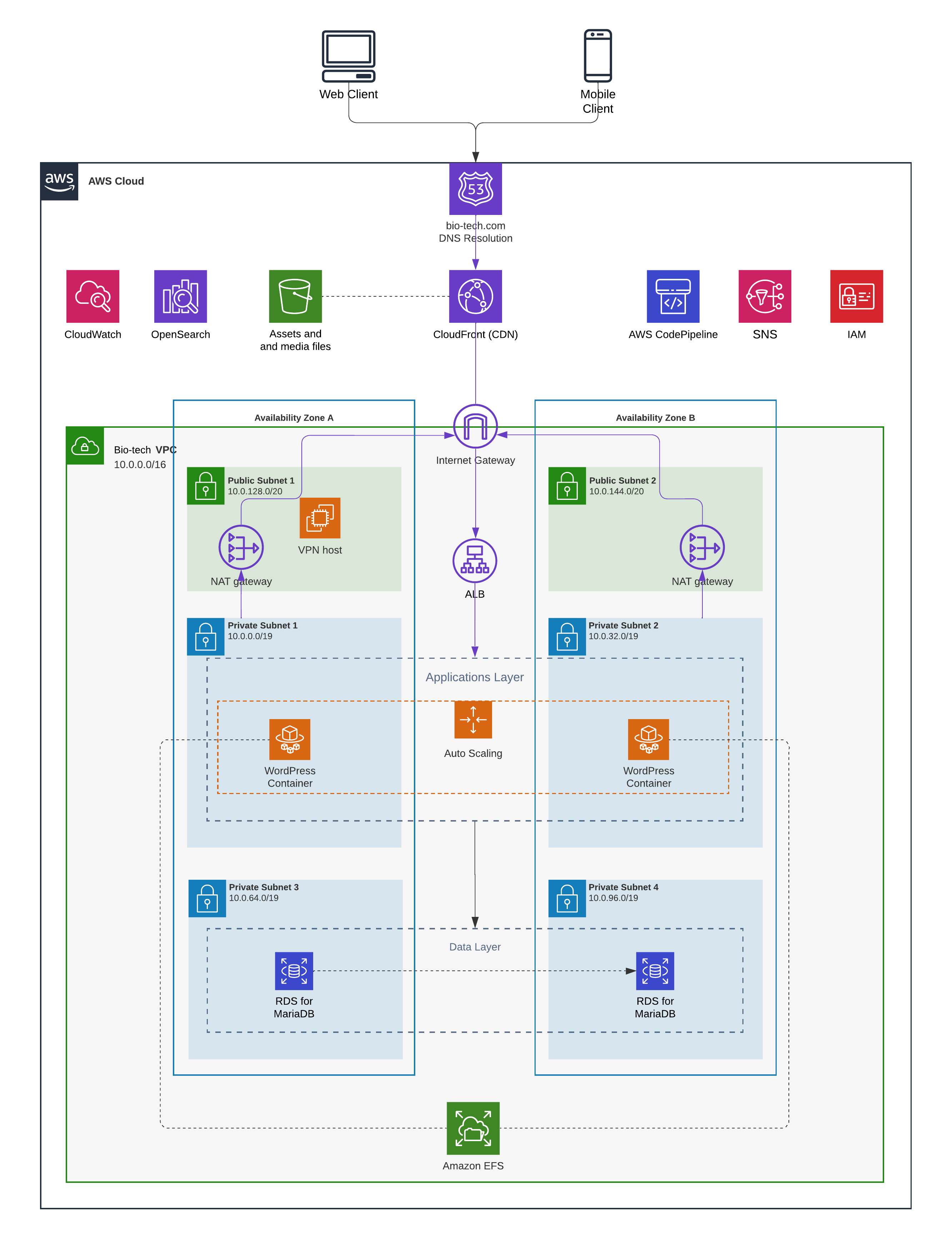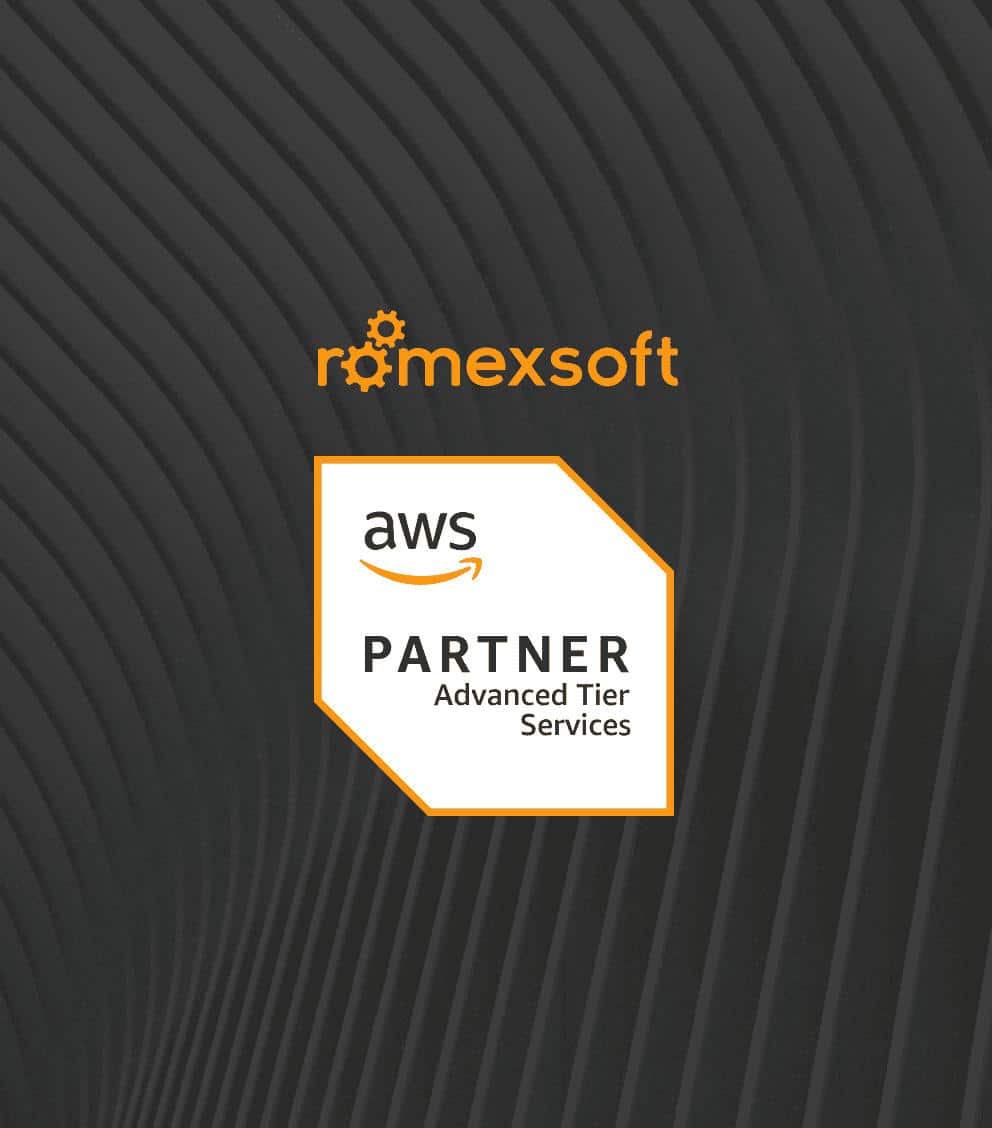Building the Website with WordPress on AWS
Discover how we transformed the client's online presence by overhauling their website with WordPress and migrating hosting to AWS.

Our Customer
Biotech Platform
A biotech firm partnered with us to pioneer a transformative approach to biomedical innovation. Their innovative solution focuses on inducing catalytic failure in real-world human models of disease, utilizing organs from deceased donors unsuitable for transplantation. This unconventional approach harnesses the untapped potential of these organs, providing profound insights into human disease and therapeutic responses.
The Challenges
Addressing Scalability and Flexibility in Web Design
After successfully launching the core platform on AWS, our client continued to develop their service and requested that we build a modern and flexible website. This website needed to effectively convey the company’s purpose, values, mission, and vision to donors’ families and investors. Previously, the client had had their website, hosted on GoDaddy and built with the GoDaddy website builder.
However, the website created with this tool, apart from having an outdated design, came with several key downsides:
Scalability issues
As our client’s business was growing, their company found that the website builder couldn’t fully accommodate the expanding needs: in terms of functionality, IT infrastructure capabilities, and integration with other tools and services.
Limited flexibility
GoDaddy website builder offers templates and drag-and-drop features for user convenience, yet its customization capabilities are limited. Clients seeking specific designs and functionalities may find the platform restrictive compared to other more adaptable options.
Cost over time
While the builder might appear budget-friendly at the outset, costs can escalate as you incorporate necessary features or expand your site. Alternative platforms may provide greater value at the same or a lower price, particularly in terms of hosting and functionalities.
SEO limitation
GoDaddy builder offers basic SEO tools, however they may not be as comprehensive or customizable as those available with other platforms. Over time, this could impact the site’s ability to rank well in search engine results.
The Solution
AWS Wordpress Architecture Setup
Moving to WordPress on AWS hosting
With comprehensive full-cycle software development capabilities, we proposed re-architecting the old website using the WordPress CMS Engine. This platform not only offers easy maintenance, enhanced flexibility and wider design customization options but it also effectively eliminates all the limitations and drawbacks presented by the previous website builder. Drawing from our own experience, we’ve seen these benefits firsthand, as Romexsoft’s website is built with WordPress on AWS too.
Our client’s primary solution operates on AWS. Therefore, Romexsoft recommended hosting the website on AWS as well, taking into account the most suitable deployment strategy. The options considered were utilizing Amazon Lightsail or opting for a Dockerized application managed by ECS Fargate.
Enterprise architecture redesign on AWS WordPress
Considering the client’s current infrastructure setup, which includes routing through CloudFront and Application Load Balancer (ALB) as well as distinct Sandbox/Production environments within an Infrastructure as a Code (IaaC) framework, with ECS on AWS Fargate as the primary computing service, our experts decided to construct the new website’s infrastructure using the following configuration:
Serverless architecture
By adopting a serverless architecture with Amazon ECS on AWS Fargate, the client benefits from a highly scalable and managed container orchestration service. This approach ensures efficient resource allocation, enabling the website to seamlessly handle fluctuating loads. It significantly reduces the operational overhead associated with managing the underlying infrastructure, which is a crucial advantage.
Efficient cloud storage
With Amazon EFS, the client benefits from a scalable and reliable file storage solution. This capability allows the website to store and access shared files efficiently across multiple containers, ensuring application-wide data consistency and eliminating the need for hardware management tasks.
Data security and integrity
By leveraging AWS RDS for MariaDB, we secure data integrity and security for the website. The managed database service provides automated backups, scaling capabilities, and built-in encryption, enhancing website performance and security. It offers a safeguard against data loss, simplifies recovery after accidental deletions or system failures, and ensures the site stays responsive and efficient, even at peak usage.
High performance and reliability
We leveraged the Application Load Balancer (ALB) to enhance the website’s availability and fault tolerance. ALB intelligently distributes incoming traffic across multiple targets, like Fargate containers, optimizing overall performance and reducing downtime risks associated with server failures.
Automated builds and deployments
With AWS CodeBuild and CodePipeline services, we automated the development cycle, diminish manual errors, and maintain consistency in releases. Consequently, the client can swiftly and proficiently roll out updates to their audience, improving user experience and engagement.
WordPress on AWS Architecture

The Results
Scalable, Secure, and Cost-Effective Architecture on AWS Wordpress
Improved flexibility and customization
WordPress on AWS provides the client with a highly flexible and customizable platform. They can easily update content, add new features, and tailor the website’s design to align with their evolving brand identity and messaging.
Enhanced scalability and performance
By migrating the website to AWS, the client now benefits from the elevated scalability and performance of their online platform. AWS’s infrastructure allows for seamless scaling based on demand, ensuring the website can handle spikes in traffic without compromising user experience.
Strengthened security and reliability
AWS’s robust security measures ensure the website’s data remains secure. Additionally, the use of ALB and CloudFront enhances reliability and availability, minimizing downtime and ensuring continuous access for visitors.
Streamlined development and deployment
The implementation of tools that ensure automated deployments streamlines the entire biotech software development and deployment process. This results in a faster time-to-market for updates and new features, empowering the client to stay ahead of the competition.
Savings on IT staff and operational overhead
The client achieved annual savings of up to 20% on IT infrastructure costs and an additional 15% on IT support expenses. Moreover, as there is no longer a need to dedicate resources to maintaining the website, it enables the client to allocate these resources toward business initiatives that drive growth and competitive advantage.
Why Romexsoft
Delivering Business Value with WordPress on AWS
We build and support enterprise-grade WordPress architectures fully optimized for AWS. As part of our broader web application development expertise, our engineers design serverless, containerized environments that deliver scalable, resilient, and compliant websites, aligned with AWS Well-Architected best practices.
Our AWS WordPress implementations have delivered measurable value:
- Strengthened data security and compliance using native AWS security services
- Seamless migration from GoDaddy to AWS-hosted WordPress with zero downtime
- Continuous uptime ensured via high-availability, auto-healing infrastructure
- Faster release cycles with automated CI/CD pipelines on AWS CodePipeline and CodeDeploy.
AWS WordPress Architecture FAQ
A well-architected AWS WordPress setup typically includes the following key components:
- Amazon ECS on Fargate or EC2 – runs the WordPress application containers.
- Amazon RDS – manages the database with backups and scaling.
- Amazon EFS or S3 – stores shared files and static content.
- Application Load Balancer (ALB) – distributes traffic across instances.
- Auto Scaling – adjusts resources automatically to meet demand.
- Amazon CloudFront – accelerates global content delivery.
- Amazon Route 53 – ensures reliable DNS and domain management.
Security and compliance in a WordPress on AWS setup are addressed through multiple AWS-managed features and best practices. Access is controlled with IAM policies and secure networking inside a VPC. Data is protected using encryption at rest and in transit, while automated backups ensure recoverability. For compliance, services such as AWS WAF, CloudTrail, and GuardDuty can be integrated to meet industry standards like HIPAA, GDPR, or PCI DSS. This layered approach ensures that WordPress websites remain both secure and compliant with regulatory requirements.
Key performance indicators include latency for page load speed, cache hit ratio to measure CDN efficiency, and database CPU/IO usage to monitor query performance. Cost-related KPIs such as cost per request or infrastructure spend per visitor can also be tracked. Together, these metrics provide clear visibility into speed, reliability, and cost efficiency of the WordPress environment on AWS.
WordPress on AWS is often chosen for its ease of use, faster setup, and lower cost of ownership, making it a strong fit for marketing websites, blogs, and corporate portals. Drupal on AWS provides greater flexibility and granular content management for complex, large-scale sites with custom workflows. Magento on AWS is tailored for e-commerce, offering advanced catalog management, payment integrations, and scalability for online retail. Each CMS can run on a similar AWS reference architecture, but WordPress stands out as the most accessible and cost-efficient option for businesses that prioritize speed and simplicity.


